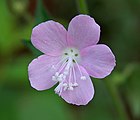Note: This is a project under development. The articles on this wiki are just being initiated and broadly incomplete. You can Help creating new pages.
Pavonia zeylanica
Plumbago zeylanica, commonly known as Ceylon leadwort, doctorbush or wild leadwort, is a species of plumbago with a pantropical distribution. Carl Linnaeus described the paleotropical P. zeylanica and neotropical P. scandens as separate species, but they are currently considered synonymous.
Contents
[hide]- 1 Uses
- 2 Parts Used
- 3 Chemical Composition
- 4 Common names
- 5 Properties
- 6 Habit
- 7 Identification
- 8 List of Ayurvedic medicine in which the herb is used
- 9 Where to get the saplings
- 10 Mode of Propagation
- 11 How to plant/cultivate
- 12 Commonly seen growing in areas
- 13 Photo Gallery
- 14 References
- 15 External Links
Uses
Skin diseases, Menstrual disorders, Viral warts, Chronic diseases of nervous system[1]
Parts Used
Chemical Composition
Preliminary phytochemical analysis revealed the presence of sugars, steroids, flavonoids, alkaloids, quinones, phenols, tannins and terpenoids in its roots. [2]
Common names
| Language | Common name |
|---|---|
| Kannada | Sewanakudri, Antugogari, Shivana kadle |
| Hindi | |
| Malayalam | |
| Tamil | Mammatti |
| Telugu | Chinnamuttava |
| Marathi | NA |
| Gujarathi | NA |
| Punjabi | NA |
| Kashmiri | NA |
| Sanskrit | Balaa |
| English | Ceylon Swamp Mallow |
Properties
Reference: Dravya - Substance, Rasa - Taste, Guna - Qualities, Veerya - Potency, Vipaka - Post-digesion effect, Karma - Pharmacological activity, Prabhava - Therepeutics.
Dravya
Rasa
Guna
Veerya
Vipaka
Karma
Prabhava
Habit
Identification
Leaf
| Kind | Shape | Feature |
|---|---|---|
| Simple | Leaves are lance-shaped to ovate | Leaves are 1.5-3 cm long, 1-2.5 cm broad. Lower ones are usually 3-lobed - lobes oblong or obovate, entire or irregularly toothed, middle one longest. |
Flower
| Type | Size | Color and composition | Stamen | More information |
|---|---|---|---|---|
| Bisexual | Lance-shaped | Pink | Flower stalk is 2-4 cm long. Sepal-like bracts are 8-11, 1-1.3 cm long. Flowers are 1.5 cm long. Flowering from July to November and March to May |
Fruit
| Type | Size | Mass | Appearance | Seeds | More information |
|---|---|---|---|---|---|
| Simple Fruit | Spherical | 5 mm across | Velvety | Fruiting from March to May and March to May |
Other features
List of Ayurvedic medicine in which the herb is used
Where to get the saplings
Mode of Propagation
How to plant/cultivate
Prefers a position in full sun or partial shade, Slightly acidic soil. Plants can flower throughout the year. [4]
Commonly seen growing in areas
Photo Gallery
References
- Jump up ↑ Karnataka Medicinal Plants Volume - 2 by Dr.M. R. Gurudeva, Page No. 291
- Jump up ↑ Chemical composition
- Jump up ↑ Kappatagudda - A Repertoire of Medicianal Plants of Gadag by Yashpal Kshirasagar and Sonal Vrishni, Page No. 298
- Jump up ↑ Cultivation Details
External Links
- Ayurvedic Herbs known to be helpful to treat Skin diseases
- Ayurvedic Herbs known to be helpful to treat Menstrual disorders
- Ayurvedic Herbs known to be helpful to treat Viral warts
- Ayurvedic Herbs known to be helpful to treat Chronic diseases of nervous system
- Herbs with Flower used in medicine
- Herbs with Leaves used in medicine
- Herbs with Root used in medicine
- Herbs with common name in Kannada
- Herbs with common name in Tamil
- Herbs with common name in Telugu
- Herbs with common name in Sanskrit
- Herbs with common name in English
- Habit - Herbs
- Index of Plants which can be propagated by Seeds
- Herbs that are commonly seen in the region of Lowland forest
- Herbs
- Malvaceae



